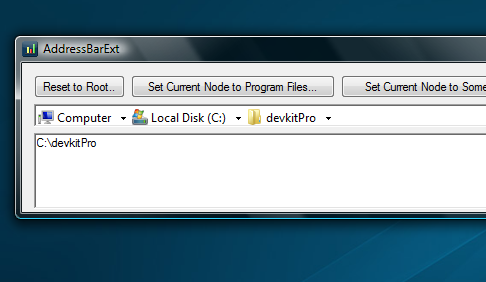
Introduction
Whilst Windows Vista still sits in amidst much controversy and discussion, a few of the features/changes it implemented have been quite cool. However, Microsoft failed to really let slide some of the cool UI changes down to us normal (or student) developers.
This article/code sample contains a personal implementation of the Vista-Style address bar for use in .NET/WinForms applications. It's based around a simple Tree/Node traversal that can be inherited to browse whatever you like.
Included in the demo is an example implementation that browses the file system tree, though it is limited in functionality (it was only made to illustrate how it all works :)).
Using the Code
The easiest way to understand the code is to download it and open it and have a play about.
The simplest way to use the bar is to drop it onto your form in Design view, then in the constructor of your form add the following code:
this.AdBar.InitializeRoot(new FileSystemNode());
All you need to do is pass it a root node, and the node itself should provide the information directly to the control. The FileSystemNode provides a basic enumeration of the first logical drive found on your Windows Install.
To implement the IAddressNode class, there are a few simple Properties to override and implement, then three real methods to implement yourself:
UpdateNode() - Used to update the node itself for any changes (e.g. in the FileSystemNode it checks for child folder changes and folder name changes)GetChild() - Searches for a given child node based on a unique ID (A Unique ID being whatever you define it as. In FileSystemNode, we use an absolute path for a folder as the unique ID).Clone() - Clones a given node as a separate value copy (rather than just by reference).
Conclusion
It's simple and relatively lightweight, it just needs you to implement your own IAddressNode derivatives to let it traverse any hierarchical structure you see fit. :)
History
- 7/3/2009 - First upload of code to CodeProject
- 29/12/2009 - Version 2.0 Supporting "My Computer" root node and VS2008, various bug fixes
- 10/4/2010 - Version 2.1 Fix to overflow behaviour to make use of available space better. Slight optimization to overflow generation.
 General
General  News
News  Suggestion
Suggestion  Question
Question  Bug
Bug  Answer
Answer  Joke
Joke  Praise
Praise  Rant
Rant  Admin
Admin 








 I'm going to investigate the issue and see about getting a fix up sometime shortly!
I'm going to investigate the issue and see about getting a fix up sometime shortly!